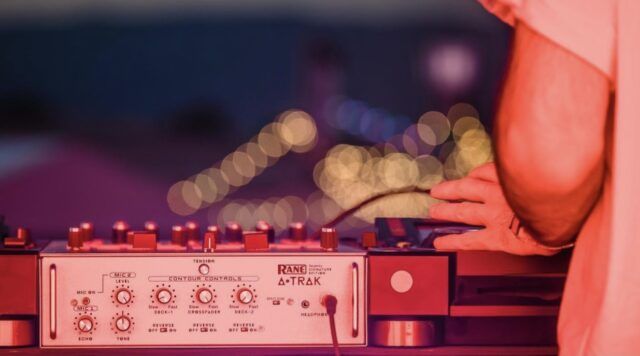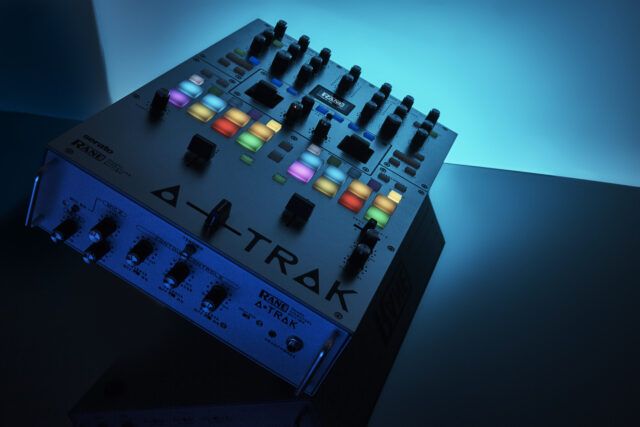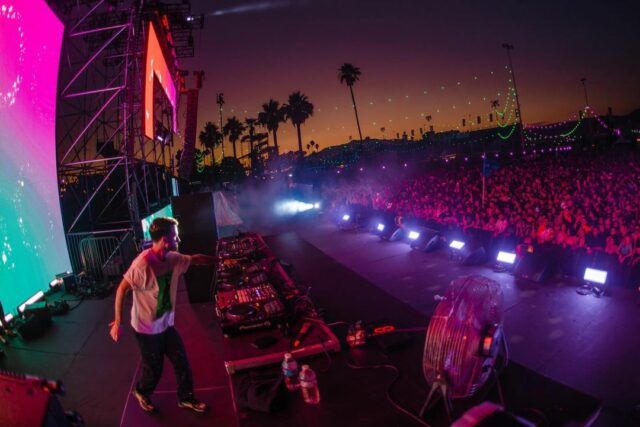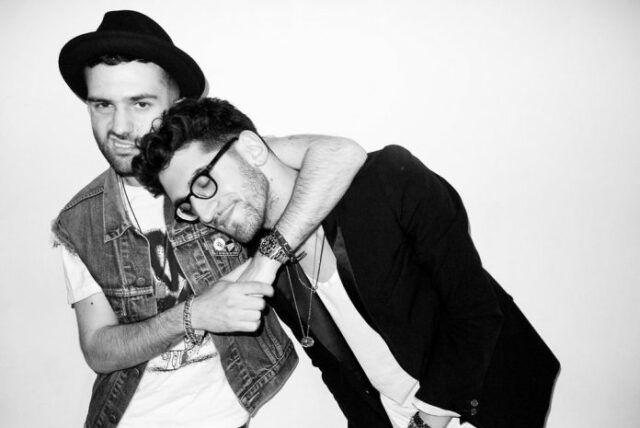Canadian-born A-Trak has been a known commodity in the music and DJ industry since he won the 1997 DMC World championship at 15 years of age. Known as much for his prolific music production career as his DJ prowess, A-Trak has remained a staple in the DJ and electronic music scene for over two decades.
With the recent release of the Rane Seventy A-Trak Signature Edition, A-Trak sat down with DJ Soo to discuss the new mixer. Read on to hear what the former DMC world champion, Fool’s Gold label founder, and Grammy-nominated music producer has to say about his involvement with the design of the mixer, his thoughts on the evolution of DJing technology, his current music project with his brother Dave 1, and more…
The Rane Seventy A-Track Signature Edition

DJ Soo: As far as I know, Rane DJ has only worked with two DJs before to create a branded special edition. Grandmaster Flash had a special edition of the Rane Empath. Z-Trip, of course, had his own version of the Sixty-Two.
And now we have you, with Rane Seventy. How does it feel to be only one of three DJs in the last twenty years to have your own special edition mixer?
A-Trak: It’s amazing! It’s always been a dream to have a signature mixer. I’m ecstatic to have [the Seventy A-Trak Signature Edition] out. And obviously, I’m happy that it’s a mixer that I like that I want to use.
I think there could have been a scenario of a brand approaching me with the possibility of doing a mixer that I don’t particularly like. But, in this case, I love the Seventy – so [it] just worked out well.
DJ Soo: Was this your personal mixer?
A-Trak: When we started talking – these conversations [with Rane] started two summers ago – the Seventy wasn’t out yet. So this all began when the Seventy was still a secret and being planned. Rane had this plan of putting out the standard Seventy, along with some signature edition.

DJ Soo: I remember reading that you had a hand in designing the sound signature. I’m assuming you worked on the look and the choice of the rotary knobs as well. What else did you have involvement in?
A-Trak: The scope of what I customize on the mixer is the design, materials, and cosmetic stuff. The sound curve was modified a little bit to my specs. Features like the fader effects were also something I suggested and tested in detail.
DJ Soo: Why the chrome color? Is it something you particularly liked?
A-Trak: Yeah, I thought it looked cool. We obviously wanted it to look different from the standard black mixer, so we went over different references of other pieces of equipment. Mostly mixers, but even the old amps… It was pulling references of mixers, amps, and pieces of audio equipment from different eras – some classic Seventies stuff and some mixers from the 90s heyday of turntablism too. But [we were] also trying to make sure that it looks unique and futuristic. I didn’t want it to be retro. And that was one thing that I wanted to be careful with because rotary knobs have a retro connotation. So I wanted the rest of the mixer to stand on its own and be its own statement.
That whole process was super interesting: learning to understand how these mixers are made and what’s possible in terms of customization. Because Rane has its own process of manufacturing, they had to understand what materials were available and how the ink is printed on the faceplate.
I would send references, and they would send back samples from plants in different parts of the world.
DJ Soo: Could you see yourself designing more mixers in the future?
A-Trak: Yeah, sure. I’d love to do more. Right now, I’m obviously focused on this one – this is two years in the making. So at this point, I’m just excited that this is actually happening.
I definitely have other ideas. What was fun with this one was trying to make the ultimate turntablist performance mixer, but make it in a way that it can be used in any venue.
The custom sound signature
A-Trak: That’s where the sound curve comes in. When I play big festivals on massive sound systems, there are limited choices as far as what mixers can be brought that are turntablist-friendly and can also deliver the type of sounds that’ll match the performance of a big four-channel mixer on those systems.
That’s been an ongoing mission in my career. Over the years, I went from a niche turntablist DJ to someone who played different genres of music, and in all types of venues. It became about figuring out certain things with the gear I use that would allow me to have the tools at my disposal to do the tricks that make me stand out as a DJ. This meant both the turntablist-type tricks in a venue where you don’t see it normally and ensuring that the sound quality can compete with the tools that another DJ is using.
With that in mind, we went into detail on the full range of the frequency response on this mixer to have it be competitive when you bring it into those massive sound systems?
DJ Soo: I read something about the mixer’s low-end being a little bit more pronounced?
A-Trak: Yeah, that’s where I spent some time. I didn’t boost anything. Nowadays, tracks are mastered so loud, it’ll just distort if you turn anything up – so it wasn’t a question of enhancing. When I play on big systems, I’ve noticed that there are some tracks with a lot of detail and depth and a certain balance in the low end. I wanted to make sure it would translate with this mixer.

While I think that the standard Seventy sounds really great, I wanted to get even more of a nuanced response on the depth of the low ends. I played a couple of tracks with very detailed low-end and subs and jotted down notes on which tracks I felt maybe warrant giving me the depth of the nuance that I wanted.
DJ Soo: Would you say that there’s some harmonic saturation or an EQ change?
A-Trak: It’s not saturation because I needed this sound to work on absolutely any track. It’s actually EQ work. We ended up finding the curve that I wanted by making very subtle dips elsewhere on the frequency spectrum, which allowed some room for the low end without losing anything noticeable elsewhere.
It ended up being eye-opening to this kind of work. A lot of music is mastered either very loud or covering the entire range of the [frequency] spectrum. As a result, I needed to ensure that there wouldn’t be anything delinquent going on on any track. I found that all I could do was run a variety of tracks through the mixer, look for stuff that I felt was missing, and then make sure that there weren’t any bad results with other tracks.
DJ tech and turntablism
DJ Soo: Between the Rane Seventy-Two, the Rane Seventy, the DJM-S11, the DJM-S7, and the Reloop Elite, we’re in a renaissance of 2-channel scratch and battle mixers. We went through 10 years of four-channel club mixers being the norm, and scratching was always a little bit niche – Redbull 3Style and DMCs notwithstanding.
What are your thoughts on where DJing is going with these more technical styles of DJing using these 2-channel mixers?
A-Trak: I agree that there’s a renaissance that seems to be led by technology. And then, every time something new comes out, gear-wise, that opens up new possibilities. You can tell that there’s a burst of creativity from the DJs, and that’s exciting to see.
I would also add phase to the list of new pieces of equipment that allow DJs – especially DJs who come from a tradition of two-turntable hip hop setups – to have more freedom to try things out.
For a long time, a lot of the innovation in DJ equipment was happening in the CDJ or house and techno side of things. It was interesting for me in those years, largely because it coincided with a point in time where I started playing electronic music myself.
In the mid-2000s, I started mixing electronic music into my sets, combining that with hip-hop and just experimenting. I started getting booked in events where house and techno DJs were playing electro and all the sub-genres that existed in those spaces. I saw DJs in those genres have access to equipment that was much more futuristic and forward [thinking] than the traditional style of hip-hop DJing with two turntables and a two-channel mixer.
I saw the innovation seep into the actual technique of those DJs. This was eye-opening for me because I come from turntablism, and I come from battling – which is the sort of branch of DJing that you would think is the most technically advanced.
During those years – the mid-to-late-2000s, I witnessed a bunch of house and techno DJs doing things with their gear that was much more advanced than what I saw most hip-hop DJs doing. This includes things like the plus-minus 50% on the pitch, looping being on CDJs early on, the effects themselves becoming part of the DJ set or key lock. All of that was on what I would call the sort of “house rigs” years before it made it to the hip-hop and turntable side.
The hip-hop and turntable setup stayed the same for a long time. But in the last five or so years, these new two-channel mixers became more up-to-date technologically. They had pads for cue points on software, key lock, pitch shift, or more effects that became available on both hardware and software. It felt like there was this burst of creativity that was waiting to happen.
It’s exciting to see this now because tech itself moves so fast nowadays – so I feel like it’s finally at the service of turntablism and DJ innovation.
DJ Battling
DJ Soo: Going back to your battle days, do you still follow up with things like the DMCs? What do you think of modern turntablism compared to when you were in your heyday?
A-Trak: I do keep up with it, although sometimes I have gripes with the way battles themselves are organized. This ultimately led me to start doing the Goldie Awards. But I find that there’s always great talent among the competitors. If anything, sometimes I’ll be critical about how the battles source their talent or where they go to find the competitors.
I think there was a point where battle DJing became stagnant for a while. There wasn’t a significant breakthrough for a certain period of time. What I think ended up happening was that the scene retreated into itself – where it ended up feeling pretty insular. Even musically, some of the choices felt self-referential. There were fewer routines that your average general music fan could relate to.
I think the heyday of DMC battles was in the 90s, with the VHS tapes that everyone had. There was something about those routines that anyone could appreciate. From there, turntablism got very advanced in a way where everyone was very good – but that also became closed off on itself for a while. I think that in recent years, DJing has opened up to a lot of new avenues again. Seeing a bunch of new, young DJs come into the scene, it feels like the talent is back to being very broad. And that’s exciting to me.
The Brothers Macklovitch project

DJ Soo: On a pivot: I’ve enjoyed the music you’ve been making with your brother under The Brothers Macklovitch project. If I’m not mistaken, is this the first official collab? What took so long?
A-Trak: Yeah, there’s been a few little guest spots here and there, but this has been the first time that we are making records as the two of us – Dave and I being the Brothers Macklovitch.
What took so long – just too busy, I guess? I think for a while, things were moving very fast. For Chromeo, things were moving very fast; for myself and Duck Sauce and the whole explosion of EDM, things were changing quickly. So what was expected of me as a DJ – what I felt I had to do to keep things interesting – was taking up all my time and attention span.
Something about the last few years put both my brother and me in places in our respective careers where we felt like we could have a little bit of stillness to reflect on previous years and think about what a new project could sound like. In our own process as producers, we got to the point where we had something that we could each contribute to a record, as opposed to something that he might be doing with Chromeo or something that I was doing as A-Trak.
We both got to a point where we each felt that we could bring something to the table and where it could be interesting. And I think we also needed to come up with what the style or the sound of both Brothers Macklovitch would be. We’ve been going for this earthy, jazzy, soulful house that goes back to our early years of buying records. Something like New York soul connected with the early garage sound: Masters of Work, Todd Edwards, acid jazz labels like Giant Step and Talking Loud, and a couple of bands like Brand New Heavies and Jamiroquai.
We realized that it would be fun to explore this because that was an era when we were first going to record shops. We needed to find the identity of Brothers Macklovitch and for it to be different from A-Trak, Duck Sauce, or Chromeo.
A question from Reddit
DJ Soo: I’m one of the main moderators for the DJs subreddit on Reddit. We’ve amassed about 100,000+ subscribers on our channel. So naturally, I put out the call for our community to share what questions they’d like to ask you – and decided that I’d ask you the highest-upvoted question from the subreddit.
(Also: we narrowly managed to avoid the “Would you rather fight one horse-sized duck or 100 duck-sized horses” by about three upvotes.)
So, here’s a question that Reddit would like to know: How do you feel about your transition from winning scratch battles to rocking house sets? Do you have a preference between the two? Do you prefer doing both, or more like hybrid sets where you can do a bit of both in the same set?
A-Trak: Well, there’s a chronological thing to address here. I did the battle sets in the late 90s, and I got into house music in the 2000s up until now. I still do hip-hop sets today, and I’ll still do turntablists sets nowadays as well.
Everything is part of a progression: what I’m doing now includes components of everything that I’ve done, from the mid-90s, up until now. The turntablist’s identity is still in what I do. Underground hip-hop is part of what I do. The mash-up and electro phase of the mid-2000s still pops up in what I do.
I don’t necessarily have a favorite type of set. Although, now that I think of it, every set is unique.
Sometimes I’m playing a house set that’s very pure, that barely includes actual scratching. Maybe due to the time and place of where I’m playing, it will be very satisfying because there’s something about not utilizing the thing that I’m actually best at. So as a personal challenge, it can be gratifying.
On the flip side, of course, playing a wide-ranging, scratch-heavy, throw-everything-but-the-kitchen-sink type of set is probably my comfort zone and what I’m best at. [I like] pulling out one of those in a way where I feel like I’m the only person who can do that set. That’s extremely satisfying.
DJ Soo: Excellent! Well, thank you so much. That’s my time. Great chatting with you.
A-Trak: Likewise, yeah!
The Rane Seventy A-Trak Signature Edition is now up for grabs in our DJTT Shop.





